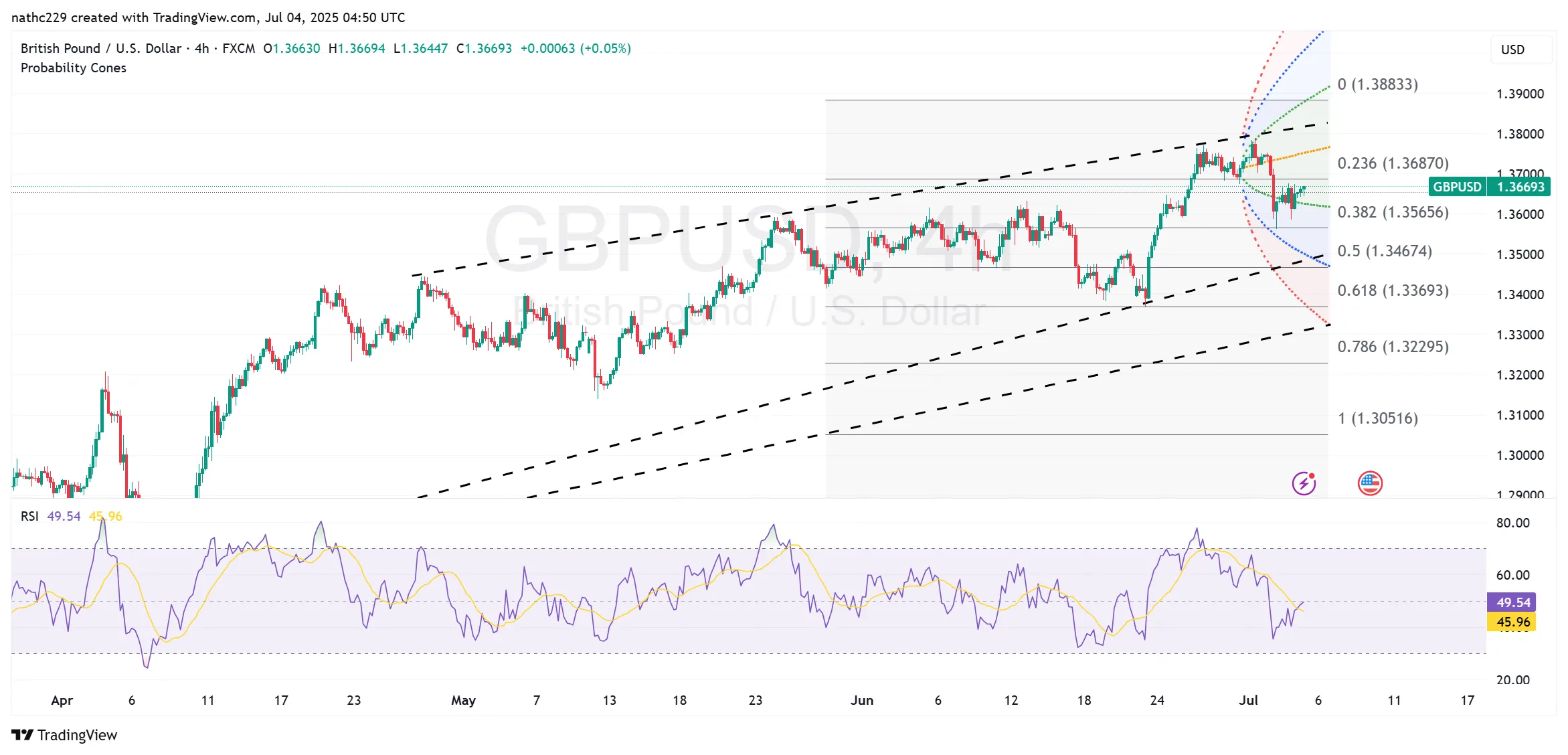
Sterling Rebounds Strongly After Robust US Payroll Data, Easing Fiscal Worries
Sterling Rebounds Strongly After Robust US Payroll Data, Easing Fiscal Worries
Overview
GBP/USD experienced significant volatility, initially dropping sharply after unexpectedly strong U.S. payroll data bolstered the dollar but quickly rebounding as market sentiment stabilized. Sterling demonstrated resilience, recovering from a session low at 1.3586 to trade around 1.3650 by the afternoon in New York, supported by improving fiscal and political sentiments in the UK.
Technical Analysis
GBP/USD initially fell to a flash low of 1.3586 following the release of stronger-than-expected U.S. employment data, reflecting a powerful bid for the dollar as Fed rate cut expectations diminished sharply. However, sterling swiftly pared these losses, moving back toward the 1.3650 level, indicating underlying bullish resilience.
Immediate support for GBP/USD is at the rising 30-day moving average at 1.3562. Additional support levels are at the June 24 low of 1.3531 and the daily Ichimoku cloud top around 1.3415. These technical levels are crucial for maintaining short-term bullish sentiment; a sustained breach below the 30-day moving average would signal potential downside momentum toward deeper support areas.
On the upside, resistance levels are initially noted at the European high of 1.3676, with further key barriers at the upper boundary of the 30-day Bollinger band at 1.3741, followed by the 2025 daily high reached on July 1 at 1.3787. A clear break above these resistance zones could significantly bolster bullish momentum, potentially targeting higher historical resistance near 1.3830 and psychological resistance at 1.3900.
The Relative Strength Index (RSI) on the daily chart remains moderately bullish, though recent volatility suggests cautious optimism as traders reassess positions following the latest economic data.
Economic Indicators and Market Factors
The U.S. payroll report significantly impacted market dynamics, initially favoring dollar strength due to the positive employment surprise. Non-farm payrolls data exceeded expectations, significantly reducing the odds of near-term Federal Reserve rate cuts and resulting in a sharp increase in U.S. Treasury yields, particularly in the 1-to-5-year maturity range.
Despite this, sterling exhibited notable resilience. Improved UK fiscal sentiment contributed to GBP/USD’s recovery as investors reassessed the severity of the previous day’s fiscal-driven slide. UK gilt yields also partially reversed earlier declines, with yields in the 5-to-10-year range falling by approximately 4 basis points, compared to a nearly 5-basis-point rise in comparable U.S. Treasury yields.
This divergence indicates that the initial sterling sell-off may have been exaggerated, providing a basis for the currency’s swift recovery. Traders now closely monitor ongoing fiscal developments, particularly any further clarification on the UK’s fiscal stance and budgetary policies, which could significantly impact sterling’s outlook.
Risks and Consequences
Despite the recent bullish recovery, GBP/USD remains vulnerable to several potential risks. A renewed shift toward a more hawkish Federal Reserve stance or more pronounced dovish rhetoric from the Bank of England could reintroduce bearish pressures.
Additionally, persistent concerns about the UK’s fiscal sustainability and political uncertainties may continue to affect market sentiment. A clear deterioration in fiscal or political confidence could quickly undermine recent bullish momentum, potentially reversing sterling’s recovery.
From a technical perspective, failure to maintain the critical support at the 30-day moving average (1.3562) could trigger a deeper bearish correction. Such a breakdown would target lower supports, notably the June low around 1.3531 and further toward 1.3415, intensifying bearish sentiment.
Trading Strategies
Given current market conditions, traders maintaining bullish positions should consider tight stop-loss placements slightly below the 30-day moving average (1.3562) to mitigate potential downside risks. Additionally, cautious bullish traders may wait for confirmation of strength above immediate resistance at 1.3676 before committing further.
Bearish traders might look for decisive evidence of renewed dollar strength or deterioration in UK fiscal sentiment before initiating short positions. Clear breaks below key support levels, especially the 30-day moving average, would provide strong bearish signals, targeting deeper corrective moves.
Conclusion
GBP/USD has shown impressive resilience despite strong U.S. employment data, supported by easing fiscal concerns and improving market sentiment. However, traders must remain vigilant, closely monitoring both technical and fundamental developments to navigate potential volatility effectively.
